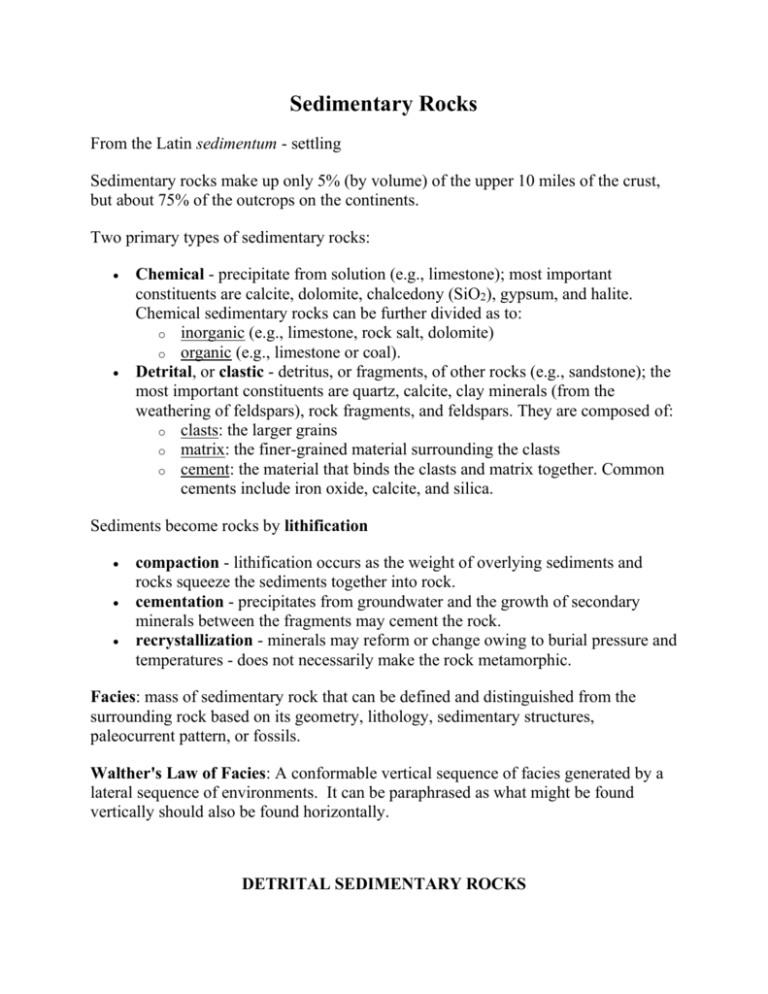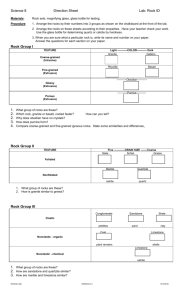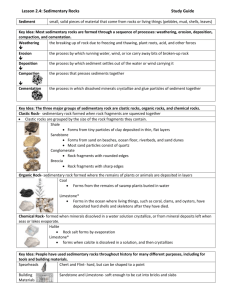Sedimentary Rocks
advertisement

Sedimentary Rocks From the Latin sedimentum - settling Sedimentary rocks make up only 5% (by volume) of the upper 10 miles of the crust, but about 75% of the outcrops on the continents. Two primary types of sedimentary rocks: Chemical - precipitate from solution (e.g., limestone); most important constituents are calcite, dolomite, chalcedony (SiO2), gypsum, and halite. Chemical sedimentary rocks can be further divided as to: o inorganic (e.g., limestone, rock salt, dolomite) o organic (e.g., limestone or coal). Detrital, or clastic - detritus, or fragments, of other rocks (e.g., sandstone); the most important constituents are quartz, calcite, clay minerals (from the weathering of feldspars), rock fragments, and feldspars. They are composed of: o clasts: the larger grains o matrix: the finer-grained material surrounding the clasts o cement: the material that binds the clasts and matrix together. Common cements include iron oxide, calcite, and silica. Sediments become rocks by lithification compaction - lithification occurs as the weight of overlying sediments and rocks squeeze the sediments together into rock. cementation - precipitates from groundwater and the growth of secondary minerals between the fragments may cement the rock. recrystallization - minerals may reform or change owing to burial pressure and temperatures - does not necessarily make the rock metamorphic. Facies: mass of sedimentary rock that can be defined and distinguished from the surrounding rock based on its geometry, lithology, sedimentary structures, paleocurrent pattern, or fossils. Walther's Law of Facies: A conformable vertical sequence of facies generated by a lateral sequence of environments. It can be paraphrased as what might be found vertically should also be found horizontally. DETRITAL SEDIMENTARY ROCKS Keys to identification and classification of sedimentary rocks: Grain size - depends on original material, length of time it has been transported, and under what conditions. Size Range Particle Sediment (millimeters) name name Detrital Rock > 256 64 - 256 4 - 64 2-4 Boulder Cobble Pebble Granule Gravel Conglomerate (rounded fragments) or Breccia (angular fragments) 1/16 - 2 Sand Sand Sandstone 1/256 - 1/16 < 1/256 Silt Clay Mud Shale (laminated and fissile) Mudstone (non laminated) Claystone Sorting - degree to which the particles are the same size, i.e. if all the particles are the same size, then they are well-sorted. The following figure shows an increase in sorting, from left to right, from very poorly sorted through to very well sorted. If we had three separate samples of silt, sand, and gravel, each very well sorted in their respective containers, but the mixed all three together, we would end up with a very poorly sorted mixture. Grain shape - reflects the degree of abrading during transport, length of transport, and resistance to weathering and abrasion. Particle sizes for the classification of detrital rocks Conglomerate - clastic rock in which the fragments are larger than 2 mm in size; fragments have rounded sides and corners. Breccia - clastic rock in which the fragments are larger than 2 mm in size; fragments have angular sides and corners. Siltstone vs. Mudstone vs. Claystone - siltstone has visible silt particles; mudstone feels gritty when chewed; claystone feels smooth when chewed; all are generally non laminated. Shale - general name for all of the very fine-grained siltstones, mudstones, and claystones that are laminated or fissile. Arenite - rock composed of any material that is sand sized (e.g., a quartz arenite is composed of sand-sized particles of quartz). Arkose - poorly sorted, clastic rock composed primarily of quartz and more than 25 percent of potassium feldspar giving it a pinkish color; usually formed from granitic rocks. Greywacke - gray to black sandstones that have a fine-grained clay, mud, or silt matrix. CHEMICAL SEDIMENTARY ROCKS Derived by the precipitation of minerals from solution (e.g., calcite or quartz). Precipitation may be caused by an inorganic process (e.g., decrease in temperature or pressure) or by interaction with an organic process. Useful chart for chemical sedimentary rocks Group Texture Composition Rock name clastic or CaCO3 limestone nonclastic clastic or dolomite CaMg(CO3)2 nonclastic (dolostone) Inorganic nonclastic SiO2 chert . nonclastic CaSO4 2H2O rock gypsum nonclastic NaCl rock salt clastic or CaCO3 limestone nonclastic Biochemical nonclastic SiO2 chert nonclastic altered plants coal Limestone - most abundant of the chemical sedimentary rocks; formed either by inorganic precipitation or by biochemical processes. Coquina limestone: a type of limestone composed of poorly cemented shells and shell fragments. Chalk: composed of the carbonate tests (shells) of foraminifera (small organisms as small as a pin head). Travertine: limestone formed by the evaporation of water. Oolitic limestone: composed of oolites which form as tiny seed particles act as the nucleus for calcite precipitation; need a swashing effect. Dolomite (dolostone): formed as magnesium in groundwater replaces some of the calcium in limestone (usually in a sabkha). Chert - a variety of cryptocrystalline (no crystal structure) silica; formed by the precipitation of silica from solution. Flint: a variety of chert which is dark owing to the presence of carbon-rich material. Evaporites - chemical sedimentary rocks that form through the evaporation of water; usually found in dry lake beds (playas). Rock salt, rock gypsum, are two examples. Coal - organic sedimentary rock composed of the remains of plant material. Various grades of coal include peat, lignite, bituminous coal, and anthracite coal. DEPOSITIONAL ENVIRONMENTS Continental: on a land mass; usually detrital. Fluvial: in a river; detrital. Lacustrine: in a lake; detrital or chemical. Paludal: in a swamp-like environment. Aeolian: by the wind; detrital. Arid: in the desert; detrital or chemical. Glacial: by a glacier; detrital. Deltaic: in a delta; detrital. Marine: in the oceans; detrital or chemical. Reef: usually detrital, occasionally chemical. Shelf: on the continental shelf; detrital or chemical. Submarine channel or fan: detrital. Pelagic: deep sea ocean floor; usually chemical. Transitional (shorelines): between land and sea; usually detrital. Linear: form long deposits (shorelines); can be detrital or chemical. SEDIMENTARY STRUCTURES A sedimentary structure reflects the depositional environment under which the rock was deposited. Bedding - sediments are arranged into layers defined by bedding planes; usually horizontal, but may also be subhorizontal or curved. Graded bedding - bedding in which the particles are sorted according to density, size, and shape. Normal grading - densest particles on the bottom. Reverse grading - densest particles near the top. Density grading - normal for lithic fragments, reverse from pumice fragments. Cross-bedding - beds that are at angle to overlying and underlying bedding. Can tell the direction of movement (paleocurrent) based on cross-bed shape. Surface features - surficial features that indicate the depositional environment. Ripple marks - wavy feature formed by wind, wave, or current. Asymmetric, or current ripples: indicative of flow in one direction; will have steeper sides on the down current side and gradual slopes on the upstream side (e.g., rivers). Symmetric, or oscillation ripples: indicative of back-and-forth flow; (e.g., tidal inlets). Both can be used to indicate which way is up in a stratigraphic section. Mudcracks - cracks formed by the desiccation, or drying, of the mud; indicative of an environment that was wet and has now dried. Can be used as an indicator of stratigraphic up; wider portion of crack will point up. Rain-drops - small imprints of rain-drops may also be found on some sedimentary rock surfaces; can be used to indicate which way is up in a stratigraphic section.









